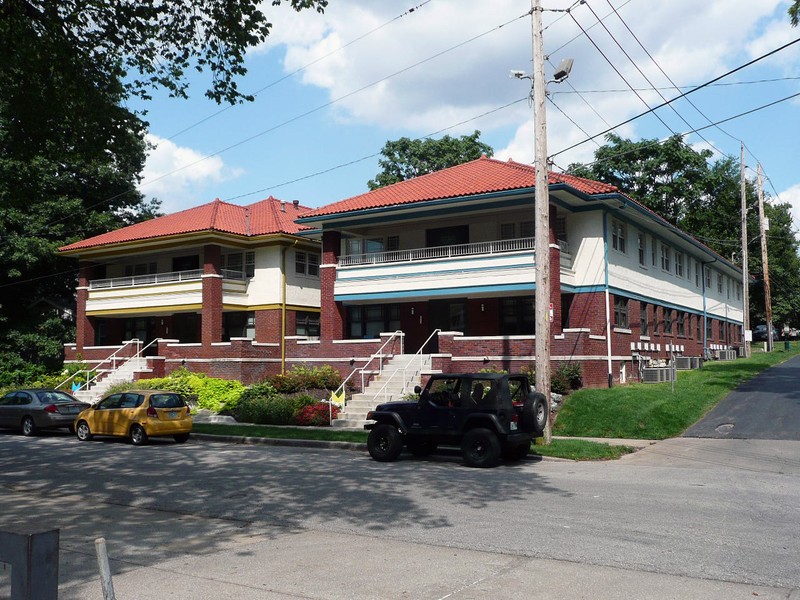Locust Street Apartments (Modern: Cleopatra and Alexander)
Introduction
Text-to-speech Audio
The twin apartment buildings, historically known as the Locust Street Apartments, enjoyed a traditional Prairie School design but had few ornate detailing and offered few amenities to the residents. Now known as the Cleopatra and Alexander apartments, they have served the Hyde Park area of Kansas City as a multi-dwelling complex since its construction finished in 1926. Like the nearby Gillham Court (1925) and Windsor Hall (1923) apartments, Locust Street mainly catered to the working class and the lower end of the middle class, demonstrating a demographic shift for the Armour Boulevard area where grand mansions and luxurious apartment-hotels had previously been erected.
Images
Locust Street Apartments now known as the Cleopatra and Alexander Apartment Buildings

Backstory and Context
Text-to-speech Audio
The Locust Street Apartments includes twin apartment buildings at 3421 and 3425 Locust Street, constructed in the late spring/early summer of 1926 for different owners. Despite the separate ownership, they are identical in design and configuration. The Praire-School-style apartments enjoyed little in ornate features, offered few amenities, and catered mainly to wage-earners and the lower-end of the middle class.
Construction of the buildings occurred during a building boom. The building boom corresponded with an exponential increase in the city's population after the turn of the (twentieth) century. The increased population included an influx of modest income earners. So, while there were plenty of luxury apartment-hotels along and near Armour Boulevard, several apartment buildings arose that catered to wage earners. Indeed, Locust Street Apartments emerged shortly after nearby Windsor Hall (1923) and Gillham Court (1925). All three apartment complexes were Low-Rise Walk-Up Apartment Building properties. Simple architectural details and straightforward building layouts lowered construction costs, which in turn reduced rents.
The arrival of apartments concurred with a significant demographic shift in the adjacent Armour Boulevard residential area. In the decades before the Locust and the neighboring apartments were built, The Hyde Park area allured wealthy residents who built grand mansions, followed by several apartment hotels that catered to affluent residents. In contrast, residents of Low-Rise Walk-Up Apartments commonly worked as managers, stenographers, clerks, maintenance workers, and tradespeople. Locust Street Tenants included both blue- and white-collar workers, most of whom were salesmen or managers in various industries. The design of the Locust Street Apartments involved providing a maximum number of apartment units within close proximity to Armour Boulevard and nearby streetcars, which offered residents access to jobs, shopping, and the greater downtown region. Each two-story building contains sixteen self-sufficient apartment units with kitchens and bathrooms. Small entrance vestibules at the single, main public entries lead to straight run, double-loaded corridors. Neither building has an elevator. The two buildings replaced earlier single-family residences, further illustrating the evolution of development in the surrounding area.
By the 1960s and 1970s, few white-collar workers called Locust Street Apartments home as the area demographic continued to evolve; the incomes of the area's residents steadily declined after World War II. But, in 2013, a renovation of the twin apartment buildings included a modern aesthetic, appliances, and cabinetry. The renovation also involved a name change as the twin buildings are now known as the Cleopatra and Alexander apartments.
Sources
Admin, Clio and Mathew Powers. "Gillham Court Apartments Building." Clio: Your Guide to History. August 20, 2021. https://www.theclio.com/entry/139175.
"Cleopatra - Kansas City Apartments." Mac Properties. macapartments.com. Accessed August 22, 2021. https://www.macapartments.com/property/Cleopatra?utm_source=%22Google%20My%20Business%22&utm_medium=Website%20Button&utm_campaign=GMB2019.
Hyde Park Neighborhood Association. "About Hyde Park: Kansas City's Historic Hyde Park." hydeparkkc.org. Accessed August 22, 2021. https://hydeparkkc.org/about-hyde-park/.
Powers, Mathew. "Windsor Hall Apartments." Clio: Your Guide to History. August 20, 2021. Accessed August 22, 2021. https://www.theclio.com/entry/139208.
Rosin, Elizabeth and Rachel Nugent. "Nomination Form: Locust Street Apartments." Archives.gov. 2011. https://catalog.archives.gov/OpaAPI/media/63817599/content/electronic-records/rg-079/NPS_MO/11000249.pdf.
By Mwkruse - Own work, CC BY-SA 3.0, https://commons.wikimedia.org/w/index.php?curid=42359170
